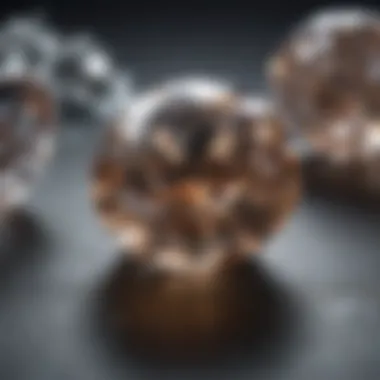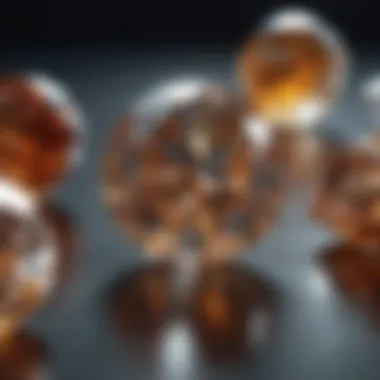Exploring Diamond-Like Materials: Properties and Impact


Intro
In the realm of materials science, diamond-like materials stand out due to their remarkable properties and diverse applications. They mimic many of the beneficial characteristics of natural diamonds, making them a point of interest for industries ranging from technology to jewelry. These materials are not just a cheap alternative to diamonds; they represent a vital innovation in materials engineered to perform specific tasks.
Understanding diamond-like materials requires a nuanced approach that encompasses their chemical structure, methods of synthesis, and the significant advantages they offer. This exploration aims to uncover the multifaceted nature of these materials, shedding light on their industrial applications and economic value, while also considering the environmental implications of their production and use. The goal is to equip readers—whether they be gemstone enthusiasts, collectors, or even jewelry designers—with a foundational knowledge of diamond-like materials that transcends superficial understanding.
Defining Diamond-Like Materials
When we dive into the world of diamond-like materials, it's crucial to have a solid understanding of what these substances are and why they matter. These materials, while not the precious gems we think of when we hear "diamond," possess certain traits that can rival natural diamonds. A broad definition encompasses various forms of carbon allotropes, synthetic substances, and even other material compounds that exhibit properties akin to diamonds. This section underscores the significance of diamond-like materials in a contemporary context, highlighting their advantages and unique characteristics. Ultimately, knowing their definition sets the foundation for understanding how they are utilized across various fields.
Characteristics and Properties
The allure of diamond-like materials lies in their intriguing properties. Among the most notable features are:
- Hardness: These materials are often characterized by exceptional hardness, making them suitable for applications that require durability. Just like natural diamonds, they can withstand scratches and wear.
- Thermal Conductivity: Diamond-like materials maintain excellent thermal conductivity, playing a critical role in heat management for high-performance electronics.
- Optical Clarity: Many of these materials exhibit clarity levels comparable to natural diamonds, allowing them to be used in optics and even jewelry.
- Chemical Stability: They often possess strong chemical bonds, offering resistance to corrosion and environmental degradation.
Each of these characteristics makes diamond-like materials an attractive option in various sectors. Whether it's for cutting tools, electronic devices, or ornaments, the diverse properties cater to a range of needs and drive innovation.
Key Differences from Natural Diamonds
While the similarities can be striking, there are distinct differences that set diamond-like materials apart from their natural counterparts. Here are some of the key points to consider:
- Origin: Natural diamonds are formed deep within the Earth over millions of years under extreme pressure and temperature. In contrast, diamond-like materials can be synthesized in controlled environments, leading to variations in quality and characteristics.
- Cost: Generally, the production of synthetic diamond-like materials tends to be more economical than mining for natural diamonds. This impacts their availability and price in the market.
- Variability: Synthetic materials can be engineered for specific properties, allowing for customization that natural diamonds cannot offer. This might include altering hardness, color, or optical properties, making them more versatile for certain applications.
- Value Perception: Natural diamonds carry a cultural and historical value that diamond-like materials lack. While the latter may share physical traits, they do not typically hold the same sentimental or status significance, which is important in markets like jewelry.
Understanding these differences not only enriches our knowledge of diamond-like materials but also helps in appreciating their growing presence in industries that rely on advanced materials for a range of applications.
Composition and Structure
Understanding the composition and structure of diamond-like materials is crucial for appreciating their unique properties and wide-ranging applications. The interplay of their chemical makeup and physical arrangement greatly influences not only their mechanical qualities but also their behavior under different conditions. This section will delve into the specific elements and benefits of composition and structure, providing insights into how these materials stand apart from natural diamonds and other alternatives, thereby shaping their value across industries.
Chemical Composition Overview
When we peel back the layers of diamond-like materials, at the core lies an intriguing chemical composition that sets them apart. While natural diamonds are composed exclusively of carbon atoms arranged in a specific formation, diamond-like materials often consist of carbon in conjunction with other elements. These additions can include silicon, boron, or nitrogen, each contributing distinct characteristics. For instance, boron can enhance the electrical conductivity of boron-doped diamond-like materials, granting them applications in electronics. Furthermore, the purity and type of carbon allotrope—like amorphous carbon or nanocrystalline diamond—can significantly influence hardness, thermal conductivity, and optical properties.
- Characteristics of Common Compositions:
- Amorphous Carbon: Lacks a defined crystal structure, often used in coatings and thin films.
- Graphene: A single layer of carbon atoms that boasts exceptional strength and electrical properties, useful in numerous technological innovations.
- Polycrystalline Diamond: Comprised of small diamond crystals, these materials maintain a high level of hardness and are ideal for cutting tools.
This chemical diversity allows for tailoring properties to meet specific industrial needs, showcasing the versatility of diamond-like materials.
Cubic Lattice Formation
The arrangement of atoms in diamond-like materials often replicates the cubic lattice structure found in natural diamonds, which is pivotal for their performance. In a cubic lattice, each carbon atom is bonded to four other atoms in a tetrahedral shape, establishing a robust three-dimensional structure. This formation results in high compressive strength and remarkable hardness, which is why these materials are often sought after in manufacturing and engineering.
The process of achieving a cubic lattice can be influenced by several factors, including temperature and pressure during synthesis. When utilizing high-pressure high-temperature methods, for example, the conditions can mimic that of natural diamond formation, leading to a product with near-identical properties to natural diamonds.
A well-structured cubic lattice not only contributes to the mechanical integrity of diamond-like materials but also impacts their optical qualities, allowing for light to be refracted in a manner that rivals natural gemstones.


In addition to the inherent benefits, the controlled manipulation of the lattice structure can lead to new innovations. By adjusting the lattice parameters, scientists are now exploring ways to enhance thermal management systems, improve wear resistance in industrial applications, and even refine the electronic properties of materials used in semiconductors.
In summary, the composition and cubic lattice structure of diamond-like materials are fundamental to understanding their distinctive characteristics and expanding their potential across various sectors. As developments in nanotechnology and materials science advance, we can expect even more remarkable attributes to emerge from these compelling materials.
Synthesis of Diamond-Like Materials
The art of creating diamond-like materials is akin to a chef mastering a complex dish; it requires precision, knowledge, and an understanding of the ingredients at hand. In this section, we will explore the different methods that scientists employ to synthesize these remarkable materials, emphasizing their importance in material science and industry. The methods discussed herein not only highlight the innovative technological advancements but also showcase the profound implications they have on economics and sustainability in the market.
High-Pressure High-Temperature Method
High-Pressure High-Temperature (HPHT) synthesis is a technique that mimics the natural conditions under which diamonds form deep within the Earth. This method is a bit of a heavyweight in the world of synthesis, as it utilizes extreme pressures and temperatures to transform carbon into diamond-like materials, just like Mother Nature does.
In layman’s terms, this method can be compared to putting an ice cube in a pressure cooker; you get a completely different outcome than if it were just left alone in the freezer. The pressure needed can reach upwards of 5 GPa, while temperatures might soar to above 1500°C. As a result, the carbon atoms undergo a huge transformation, arranged into a tetrahedral lattice structure that contributes to the material's hardness and brilliance—a hallmark of diamonds.
Key Benefits of HPHT Method:
- Quality Control: By manipulating the conditions, manufacturers can create materials with specific qualities tailored for applications in electronics, optics, and even jewelry.
- Fast Production: Compared to other methods, this one can yield results relatively quickly, making it a practical choice for industries that demand rapid turnover.
However, the HPHT technique doesn't come without its drawbacks. The initial investment in machinery and technology can be steep. Plus, there's a notable energy cost to maintain those temperature and pressure levels. Industry players need to weigh these factors against the benefits of producing high-quality diamond-like materials, particularly when market demand shifts.
Chemical Vapor Deposition
Chemical Vapor Deposition (CVD) represents another innovative approach that sets the bar higher when it comes to synthesizing diamond-like materials. Rather than relying on brute pressure and heat, this technique utilizes a gas phase reaction to deposit layers of material on a substrate, forming diamond structures atom by atom.
Think of CVD as filling a balloon with air very carefully. Each breath—a bit like carbon atoms—fills the balloon gradually, without any bursts. The beauty of CVD lies in its versatility; it allows for precise control over the growth process and lets us tailor specific material properties with high accuracy.
Benefits of CVD:
- Scalability: This method can be scaled up efficiently, supporting various material sizes, from tiny electronic components to larger industrial applications.
- Eco-Friendly: The CVD process can be designed to minimize waste and energy consumption, aligning well with sustainable manufacturing practices.
In essence, while CVD captures the spotlight for its tailored approach, companies must consider the initial setup costs and the need for stringent quality control to avoid impurities in the final product.
"Understanding the synthesis of diamond-like materials opens doors to innovative applications, positioning industries to leverage their unique properties effectively."
In summary, the synthesis of diamond-like materials through methods like HPHT and CVD represents a significant leap in material science. As these techniques continue to evolve, they hold the potential to drive economic growth while addressing sustainability challenges in various sectors.
Applications in Various Industries
The significance of diamond-like materials extends far beyond their aesthetic appeal, finding crucial applications across multiple sectors. Their unique characteristics, often including high hardness, excellent thermal conductivity, and remarkable optical properties, make them indispensable in various technological and industrial fields. In today’s rapidly evolving landscape, understanding the applications of these materials is key not only for innovation but also for fostering sustainable practices and economic growth.
Electronics and Optics
In electronics and optics, diamond-like materials are carving a niche that’s hard to ignore. Their durability and thermal stability have significant advantages, especially when it involves heat dissipation. For example, in high-performance semiconductor devices, materials like diamond-like carbon (DLC) help manage heat effectively, ensuring optimal performance and longevity.
Furthermore, when it comes to optical applications, such materials are utilized in coatings and lenses. The refractive index is often engineered to suit specific purposes, resulting in enhanced clarity and protection from wear. Abrasion-resistant coatings made from diamond-like materials ensure that screens on mobile devices maintain their integrity while enhancing the user experience.
"Materials engineered at the atomic level can unlock performance benefits in ways we are just beginning to understand."
Medical Devices and Equipment


The medical field is witnessing a transformative integration of diamond-like materials, with applications ranging from surgical tools to diagnostic equipment. The inherent biocompatibility of certain diamond-like materials allows for their use in implantable devices, where they interact lightly with organic tissues, leading to fewer complications.
Surgical instruments coated with diamond-like substances exhibit superior hardness and sharpness, minimizing the risk of human error during delicate procedures. In the realm of imaging and diagnostics, diamond-like materials enhance performance metrics for imaging devices, thus contributing to more accurate assessments of medical conditions.
Industrial Manufacturing
Within industrial manufacturing, diamond-like materials are game-changers. Their robustness under harsh conditions allows them to serve as components in machinery that require cutting, grinding, or drilling. The durability translates into longer operational life, reducing downtime and lowering costs associated with frequent replacements.
In addition, these materials play a critical role in the production of precision tools. Their exceptional hardness provides advantages in machining materials that are otherwise challenging to process, paving the way for advancements in sectors ranging from aerospace to automotive.
In summary, the applications of diamond-like materials across electronics, medical fields, and industrial manufacturing underscore their value in driving innovation, sustainability, and economic growth. As research continues and technologies advance, the potential for these materials to revolutionize various industries appears limitless.
Market Value and Economic Implications
Understanding the market value and economic implications of diamond-like materials is crucial for various stakeholders interested in this field. These materials have garnered increasing attention, not just for their physical properties, but also for their potential to disrupt traditional markets dominated by natural diamonds. The economic landscape is shifting as industries recognize the feasibility, performance, and cost benefits offered by synthetic alternatives. This section delves into the nuances of pricing, market trends, and investment prospects—essential topics for collectors, investors, and industry professionals alike.
Cost Comparison with Natural Diamonds
When it comes to pricing, diamond-like materials present a compelling case. The financial dynamics at play here differ significantly from those concerning natural diamonds. Here are a few points to consider:
- Affordability: Diamond-like materials, depending on the synthesis method, can be produced at a fraction of the cost of natural diamonds. This makes them more accessible for consumers without compromising on quality.
- Market Fluctuations: Natural diamonds are subject to market manipulations and limited supply chains, which often lead to inflated prices. Conversely, diamond-like materials are more resilient to such variations, creating a steadier pricing model.
- Quality Assurance: With advances in synthesis techniques like Chemical Vapor Deposition, producers of diamond-like materials can assure consistent quality. Natural diamonds, on the other hand, may vary wildly in clarity, cut, and color, thereby impacting their value.
In essence, while natural diamonds carry historical and cultural weight, the economic advantages of diamond-like materials are hard to ignore, particularly when it comes to price and availability.
Investment Opportunities
Investing in diamond-like materials might seem unconventional, yet the prospects are enticing for those with an eye for future trends. As industries innovate and adapt, here are some key investment opportunities:
- Technological Advancements: Companies focusing on the technological advancements of synthesizing diamond-like materials are seeing significant growth. Investing in such ventures could yield lucrative returns as the demand for high-performance materials soars in sectors like electronics and aerospace.
- Portfolio Diversification: For investors seeking to broaden their portfolios, diamond-like materials provide an untraditional yet promising asset. Their potential to mimic natural diamonds without the substantial price tag allows investors to explore new frontiers.
- Sustainability Appeal: With growing environmental concerns, materials that offer sustainable alternatives are gaining traction. Diamond-like materials often carry eco-friendly narratives, appealing to investors interested in aligning with sustainable practices.
Investing in diamond-like materials is not just a financial step but also a reflection of changing values and priorities in society. As such, it presents an opportunity to be at the forefront of emerging markets while rethinking traditional notions of value in gemstones.
In considering the economic implications of diamond-like materials, one must evaluate the blend of innovation, accessibility, and sustainability, acknowledging their potential to reshape both markets and perceptions.
Environmental Considerations
Considering the environmental impact of diamond-like materials is not just an afterthought; it is a necessity in today’s industrial landscape. As we march forward in the search for advanced materials, understanding how their production affects our planet is crucial. The effects span from resource extraction to energy consumption during synthesis, significantly shaping the future of these materials.
Production Impact
The production of diamond-like materials can have a substantial ecological footprint. Unlike natural diamonds, which often require extensive mining operations that devastate landscapes and local ecosystems, synthetic alternatives present a different set of challenges. While they spare the land from deep excavation, the energy and resource consumption tied to their manufacture can’t be ignored.
The processes involved, particularly high-pressure high-temperature (HPHT) and chemical vapor deposition (CVD), are energy-intensive. For instance, HPHT often utilizes coal and graphite, both of which contribute to carbon emissions. Furthermore, CVD, while cleaner in comparison, also demands significant electricity—sometimes drawn from non-renewable sources. This begs a vital question: What are the trade-offs between the environmental cost of producing diamond-like materials and the benefits they bring to various industries?
To evaluate production impacts, consider the following:
- Resource Consumption: Both methods require extensive raw materials, including gases and metals.
- Energy Use: High energy requirements may lead to higher carbon footprints if not sourced from renewable energies.
- Waste Generation: Industrial waste may be produced in various forms, raising concerns about proper waste management practices.
"Understanding the environmental consequences of any material’s lifecycle is not merely beneficial; it’s imperative for sustainable development."


Sustainable Practices in Production
To mitigate adverse environmental impacts, the industry is increasingly gravitating toward sustainable practices in the production of diamond-like materials. This fundamental shift not only addresses ecological concerns but also aligns with global trends toward sustainability and corporate responsibility.
- Utilization of Renewable Energy: One of the most effective ways to cut down on carbon footprints is by sourcing energy from renewable avenues—like solar or wind—to power production processes, thereby minimizing reliance on fossil fuels.
- Recycling of Raw Materials: Recycling and repurposing unused materials play a pivotal role in lowering the ecological impact. Companies are looking into closed-loop systems where waste products are re-entered into the production cycle.
- Development of Alternative Synthesis Methods: Researchers are exploring greener alternatives to current synthesis methods. Innovations in molecular engineering and the use of bioinformatics could lead to less energy-intensive production routes.
- Eco-Certifications: Some manufacturers are seeking eco-certifications, which not only validate their commitment to sustainable practices but also assure consumers that the products they purchase come with a lower environmental impact.
By embracing such sustainable practices, the industry can ensure that the growth of diamond-like materials does not come at the expense of our environment, paving the way for responsible consumption and production to coexist.
Cultural and Symbolic Significance
The exploration of diamond-like materials extends beyond their physical properties and industrial applications, reaching deeply into cultural and symbolic realms. The significance of these materials in contemporary society adds another layer of fascination. This section will illuminate the historical perspectives on gemstones, showing how they have shaped human experiences, beliefs, and customs through time.
Historical Perspectives on Gemstones
Historically, gemstones were not merely coveted for their beauty; they held substantial power in various cultures. The earliest known use of gemstones can be traced back to ancient civilizations, where they were stones of status, symbols of wealth, and tokens of power. For instance, the Egyptians were obsessed with lapis lazuli, believing it embodied the power of the sky and the afterlife. In their society, gemstones were integral to burial rituals, often placed in tombs to guide the deceased.
Different cultures assigned unique meanings to specific stones. Sapphires, most commonly blue, were believed to protect against envy and harm. The Romans regarded emeralds as symbols of love and rebirth. As time marched on, these meanings evolved, shifting depending on societal norms and circumstances.
In medieval Europe, gemstones increasingly became associated with religion and devotion. Rings set with diamonds or rubies were worn by kings and queens as symbols of divine favor and rights. The crown jewels of various nations not only showcase luxury but also embody the belief in the legitimacy of rule, a constant theme through history.
"Gems may shine, but their history often shines even brighter, entwining themselves in the tales and traditions of humanity."
Symbolism in Modern Society
In the tapestry of modern society, diamond-like materials continue to symbolize various ideas and sentiments. Unlike natural diamonds, their industrial counterparts and synthesized versions engage audiences through both aesthetic allure and ethical implications. For many, these materials represent progress, innovation, and a move toward sustainable practices in industries that once relied heavily on mining.
The term 'diamond' itself now holds a broader psychological and emotional significance. It invokes thoughts of strength, resilience, and beauty, transcending mere physical attributes. For couples, the diamond ring remains a potent symbol of enduring love and commitment, carrying forward the romanticized meanings attached to gemstones for centuries.
Today, individuals often seek alternatives to natural diamonds for ethical reasons. The emergence of synthetic diamonds is increasingly tied to contemporary values like environmental mindfulness and social responsibility. As people advocate for sustainable practices in manufacturing, these diamond-like materials often become symbols of a forward-thinking mindset that prioritizes ethical consumption.
Future of Diamond-Like Materials
The future of diamond-like materials is an exciting frontier in both science and industry. As we delve into this subject, it is essential to recognize the transformative potential these materials hold. From advancements in technology to deeper market insights, the expansion of diamond-like materials is poised to influence various sectors extensively. Their adaptability and superior properties offer solutions that traditional materials simply cannot match.
The relevance of this topic cannot be overstated as we explore potential innovations and economic trends that could shape the future landscape. Businesses and individuals alike should take note, not only for investment opportunities but also for the implications on product development and design.
Technological Innovations on the Horizon
When it comes to technological advancements, diamond-like materials are at the forefront of research and application. One such innovation includes improved methods for synthesizing these materials, like advancements in Chemical Vapor Deposition (CVD). This technique is being refined to yield higher quality materials with precise characteristics suited for specialized applications. As the process becomes more efficient, expect to see a significant drop in production costs, making diamond-like materials more accessible.
Moreover, nano-engineering is opening up avenues for creating materials that can mimic the characteristics of natural diamonds while being more lightweight and flexible. This shift can lead to new applications in electronics, where such materials can be used in semiconductors or next-gen display technologies.
"The integration of diamond-like materials into cutting-edge technology is the next big wave, pushing boundaries that we once thought were set in stone."
On the sustainability front, innovations focusing on eco-friendly production methods are gaining traction. For instance, researchers are exploring carbon capture technologies to produce diamond-like materials from atmospheric carbon, thus creating a circular economy model. Such initiatives not only create valuable materials but also address climate change concerns by repurposing carbon emissions into something useful.
Predictions for Market Trends
Given the promising developments in synthesis and application, market predictions for diamond-like materials suggest a robust growth trajectory. Analysts forecast that industries, from electronics to medical devices, will experience increased adoption due to the materials' superior properties—offering durability alongside aesthetic appeal.
Key trends to keep an eye on include:
- Rising Demand in Electronics: As smartphone and gadget manufacturers look to improve device performance and longevity, diamond-like materials might become a standard in high-performance electronics.
- Jewelry Sector Evolution: With the growing emphasis on ethical sourcing, the jewelry industry is likely to witness a paradigm shift toward synthetic stones. Consumers may prefer lab-grown options, seeing them as a sustainable alternative to natural diamonds.
- Affordable Luxury: As production methods improve, diamond-like materials are set to become more economical, allowing them to penetrate markets traditionally controlled by natural diamonds, opening doors for new consumers.
Overall, the evolving landscape suggests that diamond-like materials will not only play a pivotal role in technology and sustainable practices but also redefine consumer preferences. With continuous innovation and market opportunities, the future of these materials promises to be bright and full of potential.



